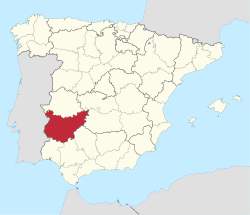Province of Badajoz
| Badajoz Provincia de Badajoz | |||
|---|---|---|---|
| Province | |||
| |||
 Map of Spain with Badajoz highlighted | |||
| Country | Spain | ||
| Autonomous community | Extremadura | ||
| Capital | Badajoz | ||
| Area | |||
| • Total | 21,766 km2 (8,404 sq mi) | ||
| Area rank | Ranked 1st | ||
| • Rank | Ranked | ||
| Demonym(s) | Spanish: pacense | ||
| Official language(s) | Spanish | ||
| Parliament | Cortes Generales | ||

The province of Badajoz (pronounced [baðaˈxoθ]) is a province of western Spain located in the autonomous community of Extremadura. It was formed in 1833. It is bordered by the provinces of Cáceres in the north, Toledo, Ciudad Real in the east, Córdoba in the south-east, Seville, and Huelva in the south and Portugal in the west.
With its area of 21,766 km², it is the largest province in Spain.[1] The other province of Extremadura, Cáceres, is the second largest with 19,868 km² area. The province has a relatively lower population density in comparison to other provinces in Spain.[2]
As of 2010, the province has a population of 692,137. Its capital is the city of Badajoz.[2]
History
The province enjoyed great prominence during the Roman empire when Mérida was made one of the capital cities. When the Visigoth period ended and the Moors had invaded Spain, the Ibn-al-Aftas dynasty established a great cultural and scientific centre in the province. Many of the explorers who set out to conquer the New World under Alfonso IX were from this province.[2]
Geography
Topography
Although in many districts there are low ranges of hills, the surface is more often a desolate and monotonous plain, flat or slightly undulating. Its one large river is the Guadiana, which traverses the north of the province from east to west, fed by many tributaries; but it is only at certain seasons that the river-beds fill with any considerable volume of water, and the Guadiana may frequently be forded without difficulty. The climate is continental with great extremes of heat in summer and of cold in winter, when fierce north and north-west winds blow across the plains. Mountains, pastures and Mediterranean forests are important geographical features of this province.[1]
Administrative divisions
The Province of Badajoz is divided into 165 municipalities. After Badajoz, the capital, the principal towns are Almendralejo, Azuaga, Don Benito, Jerez de los Caballeros, Mérida, Zafra, Montijo and Villanueva de la Serena. There are also traditional comarcas (shires, but with no administrative role) in the province, including La Siberia and Llanos de Olivenza. The capital city of Badajoz is the most important commercial centers of the province.[2] The Council of Badazos has its seat in this city.
Tourist destinations
The economy of the province is based on tourism and agriculture.[2] Some of the popular tourist destinations of the province include Badajoz, Fregenal de la Sierra, Jerez de los Caballeros, Llerena, Mérida, Olivenza, Alange, Alburquerque and Almendralejo. The popular dishes include hare, patridge and various pork products. Cornalvo Nature Reserve, the ancient structure of Roman Theatre in Mérida, National Museum of Roman Art in Mérida, Alcazaba City Wall and Ibn Marwan Monument and Espantaperros Tower of Badajoz Fortress are popular tourist spots.[1]
In 1980 architect José Rafael Moneo Vallés made his plans for the National Museum of Roman Art. Construction was finished by 1985. The architect designed the museum to have a Roman feel and look. Romans used to control present-day Spain, also known as the Iberian Peninsula, in the years following their arrival around 295 BC. Today, Mérida has the greatest number of noteworthy Roman buildings still surviving. It is also famous on an archaeological basis. The museum exhibits remnants of Roman infrastructure and dwellings, including those showing Christian influences like a basilica, and tombs. Inspiration for the National Museum of Roman Art dates back to 1838, when the city located the museum in a church, Santa Clara.[3]
See also
Notes and references
-
 Chisholm, Hugh, ed. (1911). "Province of Badajoz". Encyclopædia Britannica (11th ed.). Cambridge University Press.
Chisholm, Hugh, ed. (1911). "Province of Badajoz". Encyclopædia Britannica (11th ed.). Cambridge University Press.
- 1 2 3 "Tourism in Badajoz (province)". Government of Spain. Retrieved 14 September 2014.
- 1 2 3 4 5 "Guide to Badajoz. What to do and see in Badajoz". Euroresidentes. Retrieved 14 September 2014.
- ↑ Lapunzina, A. (2005). Reference guides to national architecture: Architecture of Spain. Westport, Connecticut: Greenwood Press.
External links
| Wikimedia Commons has media related to Province of Badajoz. |
Coordinates: 38°40′N 6°10′W / 38.667°N 6.167°W

